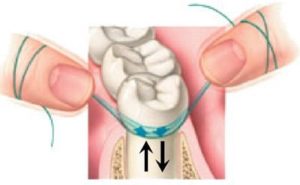The most dreaded question a dentist can ask you is, “Have you been flossing?” Many people follow the philosophy that as long as you brush your teeth, there isn’t a need to floss. This is a common misconception! Toothbrushes are designed to clean the outer surfaces and gums. However, toothbrushes cannot clean the area between your teeth properly. The only way to remove tartar build up and left over food particles is to use floss.
Exactly What Is Dental Floss?
Dental floss is a thread or ribbon that is usually made from plastic or nylon that is designed to fit in the spaces between your teeth. As you pull it between your teeth, it will remove plaque, tartar build up, and left over food particles. Flossing ensures that the spaces between your teeth will remain clean and free of buildup.
What Should I Know About Flossing?
The first step of flossing is to select a type of floss that is best suited for you. If you have tender gums, you may want to use a type of ribbon floss. Ribbon floss is softer and easier on your gums than regular threaded floss. If your gums do not show any type of sensitivity, you can use traditional threaded floss that is usually made from nylon or plastic. If you or your child has braces, you will want to use floss that has a wax coating. Traditional floss tends to be too slick, and may get tangled in the braces. The waxy covering will be easier to manoeuvre around the brackets and wires.

If you or your child have braces, flossing is even more important. Plaque and food particles build up between teeth and under braces, and can cause permanent damage to the teeth. It can also be a bit tricky at first when flossing with braces. Floss can get tangled or caught on braces quite easily. If floss gets tangled around brackets or wires, it can harm your braces. The key is to go slowly and pay close attention as to not get the floss stuck on any brackets or wires.
The Benefits of Flossing
Flossing prevents a number of oral diseases and tooth abnormalities. Flossing removes the bacteria that can cause cavities. It also prevents gingivitis, which is a mild gum disease that irritates the gums and causes them to inflame (swell) and redden.
Plaque and tartar build up cause discolouration of the teeth. Even if you brush your teeth every day, you still will not be getting rid of the bacteria between your teeth. So, while the surfaces of your teeth may be white, the sides will be discoloured. Flossing daily is not only healthy for your teeth, but it makes for a whiter, brighter smile!
